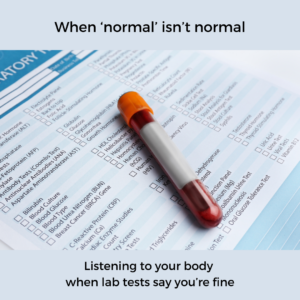What if the lab tests show there is nothing wrong with you, the labs show that your numbers are within the range of normal, but everything about the way you feel is telling you something is wrong?
In the common search for healing and well-being, conventional medicine focuses mostly on the physical aspects of health to diagnose and treat what is ailing you.
For example, if you don’t feel well, you go to your doctor and the doctor more often than not will order a series of tests to figure out what is going on and why you feel the way that you do.
You have to fall within a certain diagnostic criteria set by Western medicine for them to diagnose you with an illness and prescribe treatment.
However, what if the lab tests come back within their range of normal but you know you don’t feel normal, because actually you feel like crap and that’s why you went to the doctor in the first place?
There is certainly a place for doctors and Western medicine which is great at treating emergency and acute situations such as broken bones, serious infections, and can often offer life saving treatment. So I’m not dismissing Western medicine because it has its place and time for using it.
However, conventional Western medicine focuses on treating symptoms rather than addressing the root cause. Treatment can include monitoring, prescribing pharmaceutical drugs, and surgery.
For chronic illnesses, and especially those for which there is no defined diagnosis from a conventional medicine point of view, it can be frustrating to just be given another prescription for pharmaceutical drugs or another referral to a specialist to do even more tests. If you’ve been down this road before, you know what I’m talking about.
One important thing to note about these lab tests is that they are looking for a frank or outright sign of disease. These “normal” ranges are very broad and vary between labs.
The concept of “normal” lab ranges is based on statistical averages. The sampled population might not be representative of all demographics. Factors like age, gender, ethnicity, and lifestyle can significantly influence lab results. For instance, what is “normal” for a young, active male may not be the same for a postmenopausal woman.
Diet, stress levels, physical activity, and environmental exposures can all affect lab results. Standard lab ranges often don’t account for these critical factors.
What this means is that if you are not feeling well and experiencing symptoms such as chronic fatigue, pain, insomnia, or other symptoms, you could already be in the very early stages of a disease and your cells are already degrading, but a lab test won’t necessarily catch it.
So it’s important to listen to your body and listen to your gut when it comes to your health.
How Traditional East Asian Medicine diagnoses sickness and disease

In Traditional East Asian Medicine we use a different set of criteria to diagnose what’s going on in your body.
We focus on giving personalized care based on a holistic approach to health. We take into account the mind, body, emotions and spirit.
According to Traditional East Asian Medicine, symptoms can manifest in your body as a result of an imbalance in the different organ systems in the body. All the organs are connected and affect one another.
Anytime there is a stagnation in the body, things are stuck, and things are not able to flow smoothly, that creates an imbalance in the body that manifests as symptoms. When it’s not resolved, it can become a more serious problem and cause illness and disease.
So even though it’s not showing up in the lab results, practitioners of Traditional East Asian Medicine can determine where in the body there is an imbalance and we work on that to help make you feel better.
Traditional East Asian Medicine practitioners (also called Traditional Chinese Medicine) utilize a variety of diagnostic tools to assess a patient’s health.
One of the primary methods is pulse taking, where the practitioner feels the radial pulse at three different positions on each wrist, assessing its depth, strength, and rhythm to gain insights into the state of the body’s organs and overall energy flow.
Another critical tool is observation, where practitioners closely examine the patient’s physical appearance, demeanor, and overall vitality.
Tongue diagnosis is also important in Traditional East Asian Medicine. The practitioner examines the color, shape, size, coating, and texture of the tongue, which can reflect the condition of internal organs and the presence of heat, cold, or stagnation in the body.
Additionally, listening and smelling are used to detect irregularity in the patient’s voice, breath, and body odor, while inquiry involves asking detailed questions about symptoms, lifestyle, emotions, and overall well-being.
By synthesizing information from these various diagnostic methods, Traditional East Asian Medicine practitioners aim to identify patterns of disharmony and develop personalized treatment plans that restore balance and promote healing from within.

